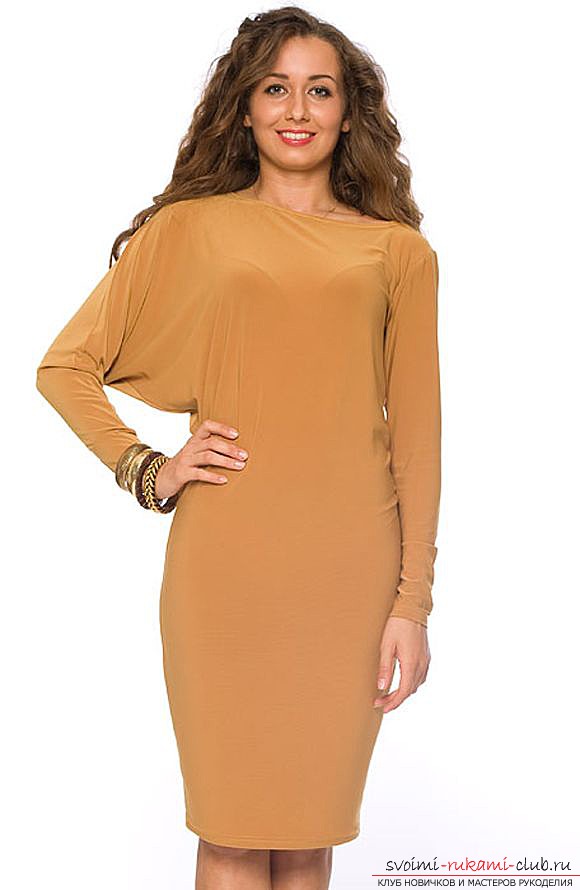
Learn how to sew knitted dresses easily by the example of a pattern of the model "Bat"
Dress made from knitwear - fascinatingoccupation. No matter how many dresses a woman has, there are still few of them. And certainly, that each of us is in a good mood after such an acquisition. In the article, it will be about how to sew a feminine, beautiful and elegant knitted dress with your own hands, with a little effort. The advantage of knitwear is that they are very practical and comfortable to wear, have an excellent appearance. The product is relevant for a woman of any age absolutely, because it does not constrain movement, and, most importantly, everything is suitable! As accessories you can use scarves and scarves, various costume jewelery, belts.  When working with knitwear it is necessary to take inattention some nuance. If you follow the basic rules with knitted fibers, you will succeed. Pattern of universal dress bat
When working with knitwear it is necessary to take inattention some nuance. If you follow the basic rules with knitted fibers, you will succeed. Pattern of universal dress bat  After the explosion of popularity in the mid-80's, thisstyle continues to be considered a stylish and fashionable outfit. There are many advantages to this type of cut. The main of them is that the clothes of this particular style are able to decorate a woman with a figure of any type. If you decide on a model dress bat that has a wide top and that is narrow over the hips, you will not lose. For women with lush forms, there are more free models, the length of which reaches the middle of the roe. Pattern is a rectangle, on top of which is left a cutout for the head. You also need to cut out the sleeves you like.
After the explosion of popularity in the mid-80's, thisstyle continues to be considered a stylish and fashionable outfit. There are many advantages to this type of cut. The main of them is that the clothes of this particular style are able to decorate a woman with a figure of any type. If you decide on a model dress bat that has a wide top and that is narrow over the hips, you will not lose. For women with lush forms, there are more free models, the length of which reaches the middle of the roe. Pattern is a rectangle, on top of which is left a cutout for the head. You also need to cut out the sleeves you like.  And we'll start with designing the dress First thingwe cut out two parts - the back and front. Do not forget to take into account your own wishes. In case you want to have a cutout "boat", both parts will be identical, and if you need a cutout "mouse", exactly the opposite.
And we'll start with designing the dress First thingwe cut out two parts - the back and front. Do not forget to take into account your own wishes. In case you want to have a cutout "boat", both parts will be identical, and if you need a cutout "mouse", exactly the opposite.  We proceed to the pattern of the remaining components: Fabric fold, so that the front side was inside. Circle outlines with chalk and draw a neck. We turn over the pattern. We put the part, move the pattern a little and draw it. We got a back, which has a characteristic middle seam. Then we draw a cuff pattern. It must match the warp thread on the selected fabric. When sewing a dress, we must add allowances:
We proceed to the pattern of the remaining components: Fabric fold, so that the front side was inside. Circle outlines with chalk and draw a neck. We turn over the pattern. We put the part, move the pattern a little and draw it. We got a back, which has a characteristic middle seam. Then we draw a cuff pattern. It must match the warp thread on the selected fabric. When sewing a dress, we must add allowances:
- on all sections of the sleeve is added from 1.5 to 2 cm.
- on the cuts of the shoulders we add from 1.5 to 2 cm.
- cut the bottom of the sleeve - 1 cm.
- lower cut - add from 3 to 4 cm.
- lateral sections of the cuff - 1 cm.
- from 1 to 1.5 cm - sections of sewing the cuff to the sleeve.
We sweep the resulting details. Then the seams need to be ironed up to 10 - 15 cm from the bottom of the product above the waist. Exactly the same manipulations must be done with the sleeves. In this case, we recede from 20 to 25 cm from the bottom. We repeat similar actions with shoulder seams and side seams of both arms. We edging the neck with a strip, and it is recommended that it be slightly stretched. Next, we need pins so that the cuffs can be pinned to the assembled bottom of the sleeve. Seams should coincide. It remains to sweep the bottom of the dress. But in order for the work done by you to look neat, you must sew it solely by hand with small stitches. Remove the threads of suggestion and iron the bottom of the dress from the wrong side. What do we end up with? A smart dress that can be worn for both a date and a business meeting. It can hide the flaws of the figure and emphasize the dignity, without creating discomfort.


